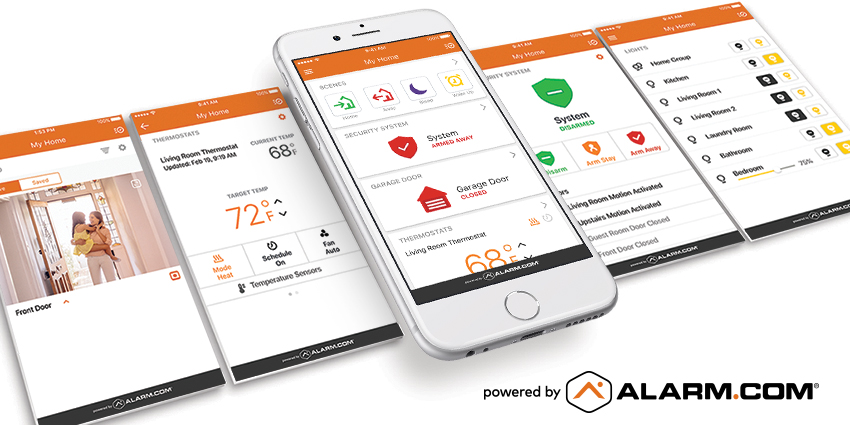Every time we install an alarm, we do so with the goal of providing the best security we can for as long as possible. Of course, with time, the amount of security an old alarm provides does eventually decline. Given enough time, any type of techonology-related equipment will begin to fail. Additionally, the changes that take place on a property over a couple decades can lead to the need for increased security. In this post, we share some indicators of an outdated security system, and how you can correct them.
For starters, we’ll look at how older security systems can fail you from a monitoring perspective. Older alarms can falter in this area in multiple ways. Then, we’ll see how age can affect the performance of your alarm’s components. As we mentioned above, electronic equipment will fail given enough time. Unfortunately, alarm-related equipment failures can have major consequences. From there, we’ll examine how your alarm’s coverage can start to fail you as you make changes to your property. In fact, we often run into situations where customers’ updated furniture and room layouts have nullified much of the alarm’s effectiveness. Finally, we will look at user experience-related frustration that older alarms can create. Now, let’s dive in with a look at how older alarms may not provide the most effective security monitoring available today.
Ineffective or Inconsistent Alarm Monitoring
The majority of our security system customers take advantage of our alarm monitoring services. Setting up this service involves connecting your security system to our central monitoring station. In turn, this connection creates communication between your alarm and our central station upon activation. Therefore, a burglary or fire-related emergency can lead to a central station response. At that point, our central station can create an emergency police or fire department dispatch if necessary.

Interactive cellular monitoring, such as the Alarm.com service pictured, allows you to control your alarm system, as well as smart home devices such as thermostats, cameras, and lights.
Older alarm systems generally utilize a customer’s existing phone lines to create this communication. Unfortunately, this often proves ineffective. For starters, traditional phone service does not provide reliable, consistent service. Phone service can fail due weather-related incidents or even car accidents involving telephone poles. Furthermore, burglars often cut a property’s phone lines before attempting a break-in. They do this to disable any attempts to call for help that you or your alarm system may make after a break-in.
Recently, new technology has created the ability for better alarm monitoring. In particular, our interactive cellular monitoring service, powered by Alarm.com, provides the best security monitoring available. For starters, this service utilizes a cellular network, rather than phone lines, for monitoring. This leads to consistent central station communication. Moreover, this service also allows you to control your security system, as well as a wide variety of smart home devices, with a smartphone! Our post sharing 5 Benefits of Cellular Alarm Monitoring covers some of the features of interactive cellular monitoring in detail. When our customers’ panels cannot take advantage of these options, we always recommend an upgrade. Next, let’s see how a system’s age can affect the performance of its security devices.
Age-Related Equipment Performance Issues
Of course, we’ve all gotten frustrated at appliances and machinery that deteriorates as it gets older. From cars to computers, toasters to microwaves, electronics all slow down as they get older. However, security system equipment ages in ways that you may not notice immediately. For example, smoke and heat detectors can have their sensitivity affected by age, especially as they cross the 10-15 year threshold. This can lead to false alarms do to oversensitivity. Conversely, it can also lead to them failing to detect smoke or heat as well! Obviously, either one of these events can spell bad news for alarm customers.
Similarly, motion detectors often react poorly to aging as well. Again, oversensitivty can lead to false alarms, with undersensitivity leading to sensors failing to recognize motion events. Testing your alarm equipment at regular intervals can help you catch these factors before they create a truly dangerous situation. In fact, we provide annual alarm check-ups for just this reason! This helps us change out equipment as needed. Taking these steps of testing and replacing equipment can help you avoid some of the major pratfalls created by an outdated security system. Let’s now focus on how your property’s changing landscape can affect your alarm’s effectiveness!
Outdated Alarm Coverage
Given time, changes to your property’s landscape often requires changes to your alarm’s coverage. For example, if you add windows and/or doors to your property, this should also come with adding alarm coverage for these areas. Conversely, existing equipment can also prove less effective after time based on changes within your building. For example, we often see motion detectors buried behind book cases or other tall furniture in both homes and businesses. Obviously, this renders the detectors useless, as they cannot sense motion through these obstacles. As you move things around on your property, keep this in mind.
Furthermore, adding a significant amount of equipment to any area can lead to the need for extra security equipment. Every so often, make sure to audit your property’s security equipment and its effectiveness given the current layout of your home or business. Last but not least, let’s take a look at how an outdated security system can prove difficult for users to understand or troubleshoot.

If you feel like you have to jump through hoops to understand your alarm status, it may be time to upgrade your security system’s equipment.
Difficult-to-Decipher System Status Updates
Every so often, your security panel will need some extra attention in order to address an issue. These issues range far and wide, including low sensor batteries, malfunctioning security sensors or smoke and heat detectors, or electrical issues within the alarm panel itself. Of course, addressing these issues effectively starts with diagnosing the problem first. Unfortunately, older alarm panels often deliver these important status updates in hard-to-decipher ways. Newer alarm panels have gone a long ways in addressing this issue.
For example, if you do have a low battery on your front door sensor, you could expect your newer alarm to read “Front Door Low Battery” on its keypad display. Moreover, burglar alarms connected to interactive cellular monitoring will even send you a text alert using plain language to communicate any issues! In contrast, older alarm panels often lack the capability to communicate these issues clearly. Instead of the message described above, you may see a cryptic message with a letter or two and a zone number. Therefore, your desired “Front Door Low Battery” message could simply read “1” on an older alarm panel. This leaves quite a bit of diagnostic work in your hands!
Furthermore, even more outdated security systems lack LCD screens entirely. Instead, these alarms communicate through blinking lights and sounds. In this case, you’d often need a user’s manual or printed guide in order to properly address your alarm’s issues. Obviously, we recommend installing a security system that can let you know what you need without jumping through these hoops. Luckily, modern alarms take this guesswork away from you entirely.
Addressing the Issues Caused by an Outdated Security System
We hope that this post helps you address any security concerns you may have related to your outdated security system. Furthermore, we encourage you to contact us with your inquiries about the material in this post. We will happily answer any questions you may have regarding updating your existing secuirty equipment. In fact, we’ve already worked with hundreds of local customers to do this over our 34 years in business (and counting!).
We generally start this process by providing a free site survey to address a property’s security needs. We provide this service to both new and existing customers alike. Therefore, we can help you upgrade your old alarm regardless of whether or not we initially installed it. While on site, we can address any changes you would like to make based on unreliable equipment performance or based on an updated property layout. Additionally, we can also make our own recommendations based on what we see during our visit. Together, we can create a plan to upgrade your security system that keeps you, your property — and everyone on your property — as safe and secure as possible!
All images used under the CC0 Creative Commons License.
